 Passover’s Message of Hope in the Aftermath of Oct. 7
Passover’s Message of Hope in the Aftermath of Oct. 7

Jewish Geography

Jewish Geography
11 min read
The fascinating story of the Jews of Brazil.
It’s not New York, Cincinnati or Philadelphia. The oldest and first Jewish community in the Americas was established in Brazil, where Sephardic Jews founded the first synagogue in Recife in 1636. This is the fascinating story of the Jews of Brazil.
Following a century of successful discovery and colonization, the Portuguese monarchy told Pedro Alvares Cabral in the year 1500 to take his ships as far west as he could to see if he could find an alternate route to India. Accompanying Cabral on this trip as the interpreter was a Jew, Gaspar da Gama.
Gaspar was “discovered” by famed explorer Vasco da Gama in India, where Vasco da Gama was shocked to find a white man serving as an advisor to one of the local rulers. VascoDa Gama decided that he could use someone who spoke the Eastern languages, so he decided to take this man back with him to Lisbon. He had the Jew convert to Catholicism and adopt the name of Gaspar da Gama in deference to the explorer.
 Famed explorer Vasco da Gama
Famed explorer Vasco da Gama
When Cabral traveled to the West, he thought it would be helpful to have Gaspar with him to converse with the natives. After crossing the Atlantic Ocean, they arrived at the land that would eventually be known as Brazil. The first man to set foot on this new land was Gaspar. Unfortunately, his knowledge of Indian dialects was of no value in trying to talk to the Brazilians, and it was then that the Portuguese settlement in Brazil began.
After discovering Brazil, the Portuguese settlers moved westward, hoping to discover gold and silver and extend their landmass. They were known as the Bandeirantes because they carried a bandeira (flag) with them. Based on their names, records suggest that many of them were conversos, hidden Jews. One of the most important Bandeirantes was Fernando de Noronha, a Portuguese converso with many contacts in the Lisbon court. He convinced the crown to lease him the land and that he would give them in exchange a wood named Pau Brazil that provided a dye and other precious items he would find. The wood that he sent gave the land the name Brazil.
#Historians suggest that his leasing scheme was an effort to help Portuguese Jews by creating a place for them to live away from the growing threats of the Catholic Church and the Inquisition.
Historians suggest that his leasing scheme was an effort to help Portuguese Jews by creating a place for them to live away from the growing threats of the Catholic Church and the Inquisition. This was crucial because after they were expelled from Spain in 1492 by the infamous Alhambra Decree, many Jewish Spaniards moved to nearby Portugal where they were far more tolerant of Jews.
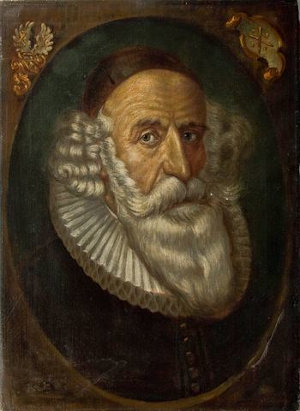 Rabbi Isaac Aboab da Fonseca
Rabbi Isaac Aboab da Fonseca
But this haven came to an end in 1497 when Portugal expelled its Jews. At this point, some Jews moved to the Netherlands, and others tried to move to the far-flung colonies, hoping to get as far as possible from the centralized government and its Inquisition. Thus, many New Christians or conversos settled in Brazil, where they would benefit from Fernando de Noronha’s settlement.
In 1600, the Dutch’s East Indies Company that imported spices and exotic products from the Far East was highly successful. So the Dtuch decided to create a West Indies Company that would import natural resources from New York, the Caribbean Islands, and Brazil, a major producer of sugar.
The Dutch defeated the Portuguese in Northeastern Brazil and began to establish a Dutch settlement there, called New Holland. The Dutch allowed religious freedom in New Holland. As a result, many Portuguese conversoswho lived in the Portuguese-controlled areas of Brazil moved to there to become full-fledged Jews once again. Two hundred Dutch Jews were also part of the original Dutch settlement. The Jews established a variety of businesses in New Holland and were particularly involved in the development of Brazil’s sugar industry.
 Street of the Jews
Street of the Jews
Most of these Jewish merchants lived onthe Rua dos Judeus - Street of the Jews. It was on this street that the first synagogue in the Western Hemisphere was built in 1636. It was called Kahal Tzur Israel, the Rock of Israel.
Synagogue records show a well-organized Jewish community with high participation, including a Talmud Torah school, a tzedakah fund, and an overseeing executive committee. In 1642, Rabbi Isaac Aboab da Fonseca, a well-knownAmsterdamrabbi, and Moses Raphael d’Aguilar came to Brazil as spiritual leaders to assist the congregations of Kahal Zur in Recife and Magen Abraham in Mauricia.
For years, the Dutch settlement prospered, but then the West Indies Companybegan to lose interest in the colony, as the profits were less than other areas under its control. The Portuguese successfully drove the Dutch out of Brazil in 1654, following a nine-year war.
In the Treaty of Guararapes, the Portuguese promised to respect the religious freedom of those who chose to remain in Brazil under Portuguese control. However, in the coming years, the Portuguese went back on their word and accused the Jews of heresy and persecuted them.
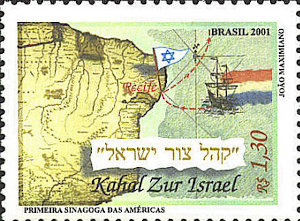 Brazilian stamp commemorating Kahal Zur Israel
Brazilian stamp commemorating Kahal Zur Israel
At that point, 150 Jewish families chose to return to Amsterdam, but others moved to Dutch-controlled areas of the Western Hemisphere. Twenty-three of these Dutch Jews traveled to New Amsterdam, today's New York. Peter Stuyvesant was the governor of New Amsterdam and did not like Jews. He asked permission from the West Indies Company to expel them, not realizing that a percentage of the shareholders were in fact Jews. He received a response from Amsterdam telling him to treat "our shareholders" with consideration.
Despite the Jews’ hope that distance would protect them from the long arm of the Inquisition, Portuguese persecution followed them to the New World. In 1647, Isaac de Castro was arrested for teaching Judaism in Portuguese-controlled Brazil. He was deported toPortugal, where the Inquisition sentenced him to death and burned him at the stake. Recognizing the danger, Jews hid their Jewish identities, immigrated to Dutch-controlled areas, or moved to the interior of Brazil where there was less oversight.
Historians have recently come across populations in Brazil's interior that have seemingly Jewish practices. These groups can’t explain why but they light candles on Friday, read only the “Old Testament,” do not eat pork or shellfish, and refrain from eating bread during Easter.
 Antonio José da Silva
Antonio José da Silva
One of the most famous cases regarding the Inquisition in Brazil was that of Antonio José da Silva. Da Silva was a law student living in Rio de Janeiro, and he also wrote several successful plays. He was denounced to the Inquisition and arrested and sent to Portugal. He refused to recant and was burned at the stake on October 19, 1739. His courage inspired Jewish and non-Jewish Brazilians and in 1996 his story was made into a Brazilian film calledO Judeu, The Jew.
In 1773, a Portuguese royal decree abolished persecution against Jews. As a result, Jews gradually settled in Brazil, although nearly all of the original Brazilian conversos had assimilated by then.
In 1822, after Brazil gained its official independence fromPortugal,Moroccan Jewsbegan moving to Brazil. In 1824, they founded a synagogue in Belem (northern Brazil) called Porta do Cebu (Gate of Heaven). By World War I, the Sephardic community of Belem, composed primarily of Moroccans, had approximately 800 members. In the 1950s, an additional wave of Jewish immigration brought more than 3,500 Moroccan Jews to Brazil.
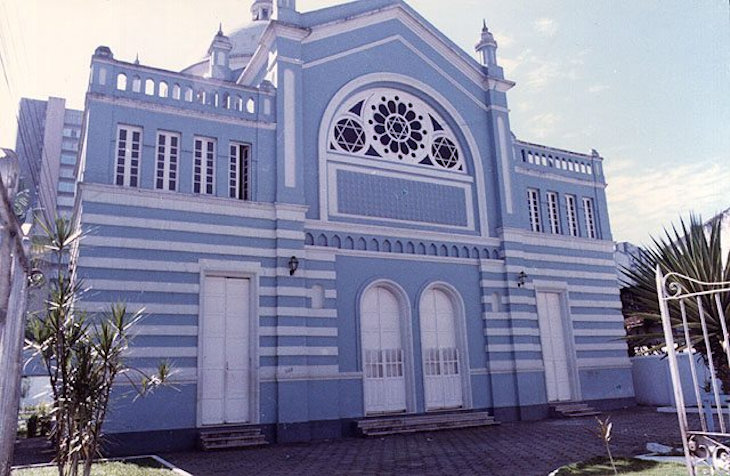 Porta do Cebu (Gate of Heaven) in Belem, Brazil
Porta do Cebu (Gate of Heaven) in Belem, Brazil
Ashkenazi European Jews began arriving in Brazil around 1850. Brazil was not the preferred destination of European Jews seeking a new life in South America. Jewish and non-Jewish Europeans tended to prefer the more cosmopolitan Argentina. At the beginning of the 20th century, Argentina had one of the highest standards of living in the world. It is possible that the immigrants who chose Brazil did so because the fare was far less than traveling by boat to Buenos Aires which was 1500 miles to the south.
Almost 30,000 Western European Jews, mainly from Germany, came to Brazil in the 1920s to escape European antisemitism. By 1929, they had established communities to the extent that there were 27 Jewish schools.
In the 1930s, Brazilian intellectuals began slandering the Jews, portraying them as non-European, impoverished communists, greedy capitalists, and detrimental to progress. The Nazi Party also encouraged antisemitism among the German diaspora, though they were far more successful in nearby Argentina.
In 1938, Brazil began an active assimilation effort and closed Yiddishnewspapers and the Jewish organizations, both secular and religious. A wave ofantisemitismfollowed, including several printings of theProtocols of the Elders of Zion. With the outbreak of World War II, Brazil adopted an immigration policy that banned any more Jewish refugees from entering the country.
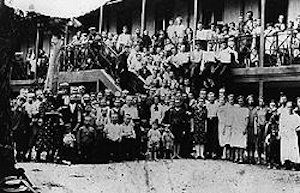 Jewish immigrants from Poland at the port of arrival in Brazil, 1926. Courtesy: Segio Zalis, Brazil
Jewish immigrants from Poland at the port of arrival in Brazil, 1926. Courtesy: Segio Zalis, Brazil
Yet, the Brazilian ambassador to France, Ambassador Luis Martins de Souza Dantas, saw things differently and heroically chose to ignore the Brazil ban on Jewish immigration. Seeing what would happen to the Jews should they remain in France, he granted immigration visas to hundreds of French Jews, saving their lives from the Holocaust.
After the Holocaust, Brazil adopted a new, more democratic constitution, and anti-Semitism decreased. Jewish immigration strengthened the community with increasing numbers, and by the 1960s, Brazilian Jewry was thriving. In the 1966 parliamentary elections, six Jews representing various parties were elected to the federal legislature. In addition, Jews served in state legislatures and municipal councils.
Horacio Lafer was the Jewish Minister of Finance in the 1950s and 1960s He was instrumental in arranging for thousands of displaced Jews from Syria, Lebanon, and other Middle Eastern countries to be able to settle in Brazil.
Today Brazil has the ninth largestJewish community in the world and the second-largest Jewish population in Latin America after Argentina. The Jewish population totals about 130,000. About 70,000 Jews live in Sao Paulo, which is the commercial and industrial heart of Brazil, and another 30,000 live in Rio
The remaining 30,000 Jews are distributed throughout the other towns in the country. In fact, there is a saying in Brazil that “if a town doesn't have a Jewish merchant, it doesn't deserve to be called a town.”
Sao Paulo Jews are particularly proud of their support of the Hospital Israelita Albert Einstein, considered by many the best hospital in all of South America. It was the first hospital outside of the United States to be accredited by the Joint Commission.
In present-day Brazil, the Jewish community lives in peace and stability and is able to practice their religion freely. In contrast to the anti-semitism that marred its history, today the greatest threat to Brazilian Jewry is intermarriage and assimilation.
At the same time, due to the efforts of many individuals, Jewish schools, adult education classes, and kosher establishments have begun to flourish.
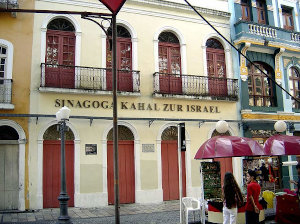 The Kahal Zur synagogue in Recife, the first shul ever built in the Americas
The Kahal Zur synagogue in Recife, the first shul ever built in the Americas
Incredibly the Kahal Zur synagogue in Recife, the first shul ever built in the Americas, was reopened in 2002, 347 years after it was closed by Portuguese colonial rule. The synagogue had not been used since the mid-17th century when the Portuguese defeated the Dutch at Recife and expelled the estimated 1,500 Jews and bannedJudaism. The synagogue is now open once again thanks to the generosity of the Safra banking family.
After World War II, Binyomin Citron was a builder and communal leader in Sao Paulo. In the early 1950’s he met with the leading American sage, Rabbi Aharon Kotler, and proudly told him about a beautiful building that he had built for use as a yeshiva, describing how he was going to produce strong educated Jews just like a great American yeshiva.
With great insight, Rabbi Kotler responded to him, “Buildings don’t create strong educated Jews, people do. If you have the right rabbis as teachers, you can produce great strong educated Jews. We will send you the best rabbi in the system to help build Torah in Brazil.” Rabbi Kotler sent Reb Zelig Privalsky to Brazil, where he and many others helped create a Jewish future for thousands of Brazilian Jews - a future for the oldest Jewish community in the Western Hemisphere.

Rabbi Menachem Levine- Teach Me More!